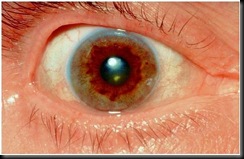Copper is is a chemical element with the symbol Cu and atomic number 29. It is a ductile metal with very high thermal and electrical conductivity. Copper is an essential trace nutrient to all high plant and animal life. In animals, including humans, it is found primarily in the bloodstream, as a co-factor in various enzymes and in copper-based pigments. However, in sufficient amounts, copper can be poisonous and even fatal to organisms which leads to Wilson Disease.
Wilson disease is a genetic disorder that prevents the body from getting rid of extra copper. A small amount of copper obtained from food is needed to stay healthy, but too much copper is poisonous. In Wilson disease, copper builds up in the liver, brain, eyes, and other organs. Over time, high copper levels can cause life-threatening organ damage.
People who get Wilson disease inherit two abnormal copies of the ATP7B gene, one from each parent. Wilson disease carriers, who have only one copy of the abnormal gene, do not have symptoms. Most people with Wilson disease have no known family history of the disease. A person’s chances of having Wilson disease increase if one or both parents have it.
Causes:
Wilson disease is caused by a buildup of copper in the body. Normally, copper from the diet is filtered out by the liver and released into bile, which flows out of the body through the gastrointestinal tract. People who have Wilson disease cannot release copper from the liver at a normal rate, due to a mutation of the ATP7B gene. When the copper storage capacity of the liver is exceeded, copper is released into the bloodstream and travels to other organs—including the brain, kidneys, and eyes.
Symptoms:
Wilson disease first attacks the liver, the central nervous system, or both.
A buildup of copper in the liver may cause ongoing liver disease. Rarely, acute liver failure occurs; most patients develop signs and symptoms that accompany chronic liver disease, including
- swelling of the liver or spleen
- jaundice, or yellowing of the skin and whites of the eyes
- fluid buildup in the legs or abdomen
- a tendency to bruise easily
- fatigue
A buildup of copper in the central nervous system may result in neurologic symptoms, including
- problems with speech, swallowing, or physical coordination
- tremors or uncontrolled movements
- muscle stiffness
- behavioral changes
Other signs and symptoms of Wilson disease include
- anemia
- low platelet or white blood cell count
- slower blood clotting, measured by a blood test
- high levels of amino acids, protein, uric acid, and carbohydrates in urine
- premature osteoporosis and arthritis
Kayser-Fleischer rings result from a buildup of copper in the eyes and are the most unique sign of Wilson disease. They appear in each eye as a rusty-brown ring around the edge of the iris and in the rim of the cornea. The iris is the colored part of the eye surrounding the pupil. The cornea is the transparent outer membrane that covers the eye.
Diagnosis:
Wilson disease is diagnosed through a physical examination and laboratory tests.
During the physical examination, a doctor will look for visible signs of Wilson disease. A special light called a slit lamp is used to look for Kayser-Fleischer rings in the eyes. Kayser-Fleischer rings are present in almost all people with Wilson disease who show signs of neurologic damage but are present in only 50 percent of those with signs of liver damage alone.
Laboratory tests measure the amount of copper in the blood, urine, and liver tissue. Most people with Wilson disease will have a lower than normal level of copper in the blood and a lower level of corresponding ceruloplasmin, a protein that carries copper in the bloodstream. In cases of acute liver failure caused by Wilson disease, the level of blood copper is often higher than normal. A 24-hour urine collection will show increased copper in the urine in most patients who display symptoms. A liver biopsy—a procedure that removes a small piece of liver tissue—can show if the liver is retaining too much copper. The analysis of biopsied liver tissue with a microscope detects liver damage, which often shows a pattern unique to Wilson disease.
Genetic testing may help diagnose Wilson disease in some people, particularly those with a family history of the disease.
Wilson disease can be misdiagnosed because it is rare and its symptoms are similar to those of other conditions
Treatment:
Wilson disease requires lifelong treatment to reduce and control the amount of copper in the body.
Initial therapy includes the removal of excess copper, a reduction of copper intake, and the treatment of any liver or central nervous system damage.
The drugs d-penicillamine (Cuprimine) and trientine hydrochloride (Syprine) release copper from organs into the bloodstream. Most of the copper is then filtered out by the kidneys and excreted in urine. A potential major side effect of both drugs is that neurologic symptoms can become worse—a possible result of the newly released copper becoming reabsorbed by the central nervous system. About 20 to 30 percent of patients using d-penicillamine will also initially experience other reactions to the medication, including fever, rash, and other drug-related effects on the kidneys and bone marrow. The risk of drug reaction and neurologic worsening appears to be lower with trientine hydrochloride, which should be the first choice for the treatment of all symptomatic patients.
Pregnant women should take a lower dose of d-penicillamine or trientine hydrochloride during pregnancy to reduce the risk of birth defects. A lower dose will also help reduce the risk of slower wound healing if surgical procedures are performed during childbirth.
Zinc, administered as zinc salts such as zinc acetate (Galzin), blocks the digestive tract’s absorption of copper from food. Zinc removes copper too slowly to be used alone as an initial therapy for people who already have symptoms, but it is often used in combination with d-penicillamine or trientine hydrochloride. Zinc is safe to use at full dosage during pregnancy.
Maintenance therapy begins when symptoms improve and tests show that copper has been reduced to a safe level. Maintenance therapy typically includes taking zinc and low doses of either d-penicillamine or trientine hydrochloride. Blood and urine should be monitored by a health care provider to ensure treatment is keeping copper at a safe level.
People with Wilson disease should reduce their dietary copper intake. They should not eat shellfish or liver, as these foods may contain high levels of copper. Other foods high in copper—including mushrooms, nuts, and chocolate—should be avoided during initial therapy but, in most cases, may be eaten in moderation during maintenance therapy. People with Wilson disease should have their drinking water checked for copper content and should not take multivitamins that contain copper.
If the disorder is detected early and treated effectively, people with Wilson disease can enjoy good health.



4 comments:
Excellent post. Thank you for this intriguing information.
Thanks for Appreciation...
I have a question. Is it possible to have copper be in the normal range in this disease.
I went to the Mayo clinic with choreoathetosis and dystonia, weakness and such. Blood work only showed low phosphorus, low potassium, high lactate and relatively low alkaline phosphotase. They never did the urine tests.
Anyway, is that possible ? You can reach me at kindlystopstaring@hotmail.com
Hi Shay
Following are details regarding your query:
Diagnostic Criteria for Wilson's disease Low serum ceruloplasmin levels < 20dL (Normal range 20-50 mg/dL).
Kayser - Fleischer rings in eyes.
High liver copper levels > 250 micrograms/g dry weight (Normal range <35 micrograms/g dry weight).
High 24 hr urinary copper levels > 100 micrograms /d or > 1.6 mmol/d (Normal range <50 micrograms/d or < 0.8 mmol/d).
However The normal range for urine copper is 20–50 μg per 24 hours. Values below this range are considered copper deficient.
Post a Comment